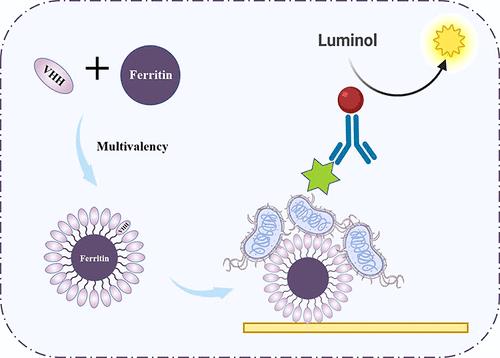当前位置:
X-MOL 学术
›
J. Agric. Food Chem.
›
论文详情
Our official English website, www.x-mol.net, welcomes your feedback! (Note: you will need to create a separate account there.)
Enhancing Nanobody Immunoassays through Ferritin Fusion: Construction of a Salmonella-Specific Fenobody for Improved Avidity and Sensitivity
Journal of Agricultural and Food Chemistry ( IF 5.7 ) Pub Date : 2024-06-19 , DOI: 10.1021/acs.jafc.4c03606 Xingrui Liao 1 , Jiamin Wang 1 , Bing Guo 2 , Mengfan Bai 1 , Yao Zhang 1 , Gege Yu 1 , Peng Wang 1 , Juan Wei 1 , Jianlong Wang 1 , Xiyun Yan 3 , Kelong Fan 3, 4 , Yanru Wang 1
Journal of Agricultural and Food Chemistry ( IF 5.7 ) Pub Date : 2024-06-19 , DOI: 10.1021/acs.jafc.4c03606 Xingrui Liao 1 , Jiamin Wang 1 , Bing Guo 2 , Mengfan Bai 1 , Yao Zhang 1 , Gege Yu 1 , Peng Wang 1 , Juan Wei 1 , Jianlong Wang 1 , Xiyun Yan 3 , Kelong Fan 3, 4 , Yanru Wang 1
Affiliation

|
Nanobodies (Nbs) serve as powerful tools in immunoassays. However, their small size and monovalent properties pose challenges for practical application. Multimerization emerges as a significant strategy to address these limitations, enhancing the utilization of nanobodies in immunoassays. Herein, we report the construction of a Salmonella-specific fenobody (Fb) through the fusion of a nanobody to ferritin, resulting in a self-assembled 24-valent nanocage-like structure. The fenobody exhibits a 35-fold increase in avidity compared to the conventional nanobody while retaining good thermostability and specificity. Leveraging this advancement, three ELISA modes were designed using Fb as the capture antibody, along with unmodified Nb422 (FbNb-ELISA), biotinylated Nb422 (FbBio-ELISA), and phage-displayed Nb422 (FbP-ELISA) as the detection antibody, respectively. Notably, the FbNb-ELISA demonstrates a detection limit (LOD) of 3.56 × 104 CFU/mL, which is 16-fold lower than that of FbBio-ELISA and similar to FbP-ELISA. Moreover, a fenobody and nanobody sandwich chemiluminescent enzyme immunoassay (FbNb-CLISA) was developed by replacing the TMB chromogenic substrate with luminal, resulting in a 12-fold reduction in the LOD. Overall, the ferritin-displayed technology represents a promising methodology for enhancing the detection performance of nanobody-based sandwich ELISAs, thereby expanding the applicability of Nbs in food detection and other fields requiring multivalent modification.
中文翻译:

通过铁蛋白融合增强纳米抗体免疫测定:构建沙门氏菌特异性 Fenobody 以提高亲和力和灵敏度
纳米抗体 (Nbs) 是免疫测定中的强大工具。然而,它们的小尺寸和单价特性给实际应用带来了挑战。多聚化成为解决这些限制的重要策略,增强了纳米抗体在免疫测定中的利用率。在此,我们报告了通过将纳米体与铁蛋白融合来构建沙门氏菌特异性 Fenobody (Fb),从而形成自组装的 24 价纳米笼状结构。与传统纳米抗体相比,fenobody 的亲合力提高了 35 倍,同时保留了良好的热稳定性和特异性。利用这一进步,设计了三种 ELISA 模式,使用 Fb 作为捕获抗体,分别使用未修饰的 Nb422 (FbNb-ELISA)、生物素化 Nb422 (FbBio-ELISA) 和噬菌体展示的 Nb422 (FbP-ELISA) 作为检测抗体。值得注意的是,FbNb-ELISA 的检测限 (LOD) 为 3.56 × 10 4 CFU/mL,比 FbBio-ELISA 低 16 倍,与 FbP-ELISA 相似。此外,通过用 Luminal 替代 TMB 显色底物,开发了 Fenobody 和纳米抗体夹心化学发光酶免疫分析 (FbNb-CLISA),使 LOD 降低了 12 倍。总体而言,铁蛋白展示技术代表了一种有前途的方法,可增强基于纳米抗体的夹心 ELISA 的检测性能,从而扩大 Nbs 在食品检测和其他需要多价修饰的领域的适用性。
更新日期:2024-06-19
中文翻译:

通过铁蛋白融合增强纳米抗体免疫测定:构建沙门氏菌特异性 Fenobody 以提高亲和力和灵敏度
纳米抗体 (Nbs) 是免疫测定中的强大工具。然而,它们的小尺寸和单价特性给实际应用带来了挑战。多聚化成为解决这些限制的重要策略,增强了纳米抗体在免疫测定中的利用率。在此,我们报告了通过将纳米体与铁蛋白融合来构建沙门氏菌特异性 Fenobody (Fb),从而形成自组装的 24 价纳米笼状结构。与传统纳米抗体相比,fenobody 的亲合力提高了 35 倍,同时保留了良好的热稳定性和特异性。利用这一进步,设计了三种 ELISA 模式,使用 Fb 作为捕获抗体,分别使用未修饰的 Nb422 (FbNb-ELISA)、生物素化 Nb422 (FbBio-ELISA) 和噬菌体展示的 Nb422 (FbP-ELISA) 作为检测抗体。值得注意的是,FbNb-ELISA 的检测限 (LOD) 为 3.56 × 10 4 CFU/mL,比 FbBio-ELISA 低 16 倍,与 FbP-ELISA 相似。此外,通过用 Luminal 替代 TMB 显色底物,开发了 Fenobody 和纳米抗体夹心化学发光酶免疫分析 (FbNb-CLISA),使 LOD 降低了 12 倍。总体而言,铁蛋白展示技术代表了一种有前途的方法,可增强基于纳米抗体的夹心 ELISA 的检测性能,从而扩大 Nbs 在食品检测和其他需要多价修饰的领域的适用性。
















































 京公网安备 11010802027423号
京公网安备 11010802027423号